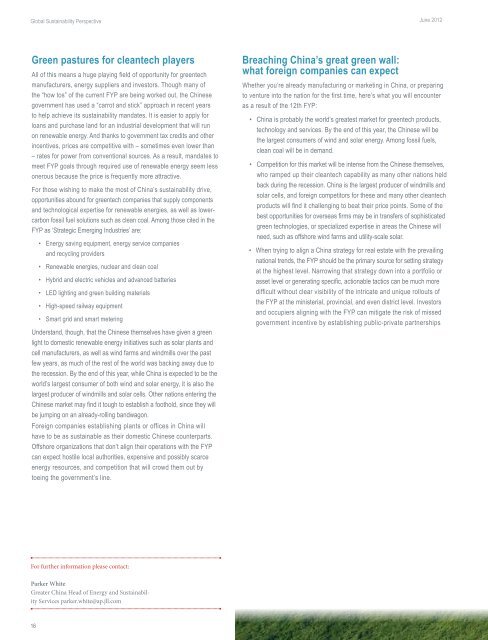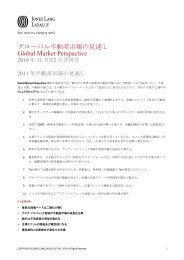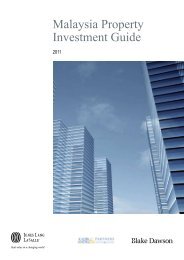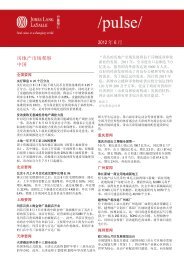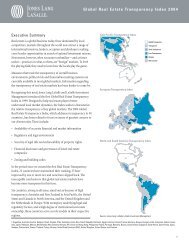Global Sustainability Perspective magazine - Jones Lang LaSalle
Global Sustainability Perspective magazine - Jones Lang LaSalle
Global Sustainability Perspective magazine - Jones Lang LaSalle
You also want an ePaper? Increase the reach of your titles
YUMPU automatically turns print PDFs into web optimized ePapers that Google loves.
<strong>Global</strong> <strong>Sustainability</strong> <strong>Perspective</strong><br />
Green pastures for cleantech players<br />
All of this means a huge playing field of opportunity for greentech<br />
manufacturers, energy suppliers and investors. Though many of<br />
the “how tos” of the current FYP are being worked out, the Chinese<br />
government has used a “carrot and stick” approach in recent years<br />
to help achieve its sustainability mandates. It is easier to apply for<br />
loans and purchase land for an industrial development that will run<br />
on renewable energy. And thanks to government tax credits and other<br />
incentives, prices are competitive with – sometimes even lower than<br />
– rates for power from conventional sources. As a result, mandates to<br />
meet FYP goals through required use of renewable energy seem less<br />
onerous because the price is frequently more attractive.<br />
For those wishing to make the most of China’s sustainability drive,<br />
opportunities abound for greentech companies that supply components<br />
and technological expertise for renewable energies, as well as lowercarbon<br />
fossil fuel solutions such as clean coal. Among those cited in the<br />
FYP as ‘Strategic Emerging Industries’ are:<br />
• Energy saving equipment, energy service companies<br />
and recycling providers<br />
• Renewable energies, nuclear and clean coal<br />
• Hybrid and electric vehicles and advanced batteries<br />
• LED lighting and green building materials<br />
• High-speed railway equipment<br />
• Smart grid and smart metering<br />
Understand, though, that the Chinese themselves have given a green<br />
light to domestic renewable energy initiatives such as solar plants and<br />
cell manufacturers, as well as wind farms and windmills over the past<br />
few years, as much of the rest of the world was backing away due to<br />
the recession. By the end of this year, while China is expected to be the<br />
world’s largest consumer of both wind and solar energy, it is also the<br />
largest producer of windmills and solar cells. Other nations entering the<br />
Chinese market may find it tough to establish a foothold, since they will<br />
be jumping on an already-rolling bandwagon.<br />
Foreign companies establishing plants or offices in China will<br />
have to be as sustainable as their domestic Chinese counterparts.<br />
Offshore organizations that don’t align their operations with the FYP<br />
can expect hostile local authorities, expensive and possibly scarce<br />
energy resources, and competition that will crowd them out by<br />
toeing the government’s line.<br />
For further information please contact:<br />
Parker White<br />
Greater China Head of Energy and <strong>Sustainability</strong><br />
Services parker.white@ap.jll.com<br />
Breaching China’s great green wall:<br />
what foreign companies can expect<br />
June 2012<br />
Whether you’re already manufacturing or marketing in China, or preparing<br />
to venture into the nation for the first time, here’s what you will encounter<br />
as a result of the 12th FYP:<br />
• China is probably the world’s greatest market for greentech products,<br />
technology and services. By the end of this year, the Chinese will be<br />
the largest consumers of wind and solar energy. Among fossil fuels,<br />
clean coal will be in demand.<br />
• Competition for this market will be intense from the Chinese themselves,<br />
who ramped up their cleantech capability as many other nations held<br />
back during the recession. China is the largest producer of windmills and<br />
solar cells, and foreign competitors for these and many other cleantech<br />
products will find it challenging to beat their price points. Some of the<br />
best opportunities for overseas firms may be in transfers of sophisticated<br />
green technologies, or specialized expertise in areas the Chinese will<br />
need, such as offshore wind farms and utility-scale solar.<br />
• When trying to align a China strategy for real estate with the prevailing<br />
national trends, the FYP should be the primary source for setting strategy<br />
at the highest level. Narrowing that strategy down into a portfolio or<br />
asset level or generating specific, actionable tactics can be much more<br />
difficult without clear visibility of the intricate and unique rollouts of<br />
the FYP at the ministerial, provincial, and even district level. Investors<br />
and occupiers aligning with the FYP can mitigate the risk of missed<br />
government incentive by establishing public-private partnerships<br />
with local government ministries. With support from professionals<br />
who have proven, on-the-ground track records of working with<br />
local governments and capturing national subsidies, creating such<br />
partnerships and necessary visibility can ensure the FYP is a tool for<br />
increasing competitive advantage rather than a bureaucratic obstacle.<br />
• Foreign companies opening manufacturing or other operations in<br />
China will likely find environmental standards for emissions tougher<br />
than those in most other locations. And there is rarely much “wiggle<br />
room”: Companies must comply or face stiff penalties, even potential<br />
cutbacks in power supply. The good news is that China is ahead<br />
of the curve on bringing down the cost of renewable energy and,<br />
with support from government initiatives, clean power should be<br />
competitively priced in coming years. There should be some carbontrading<br />
opportunities as well.<br />
• For new industrial plants and other foreign-driven developments<br />
in China, the greener the better as far as applying for loans,<br />
purchasing land, even getting basic cooperation from regional<br />
and local authorities. A plan for a sustainable facility running on<br />
clean energy will likely pass through Chinese bureaucracy much<br />
quicker than one that is not.<br />
16 17<br />
<strong>Jones</strong> <strong>Lang</strong> <strong>LaSalle</strong><br />
Not easily replicable, but not to be ignored<br />
China’s 12th FYP is “game on” for most A-list global sustainability<br />
initiatives, including carbon taxation; improved building standards and<br />
requirements; mandates for energy efficiency; several government<br />
incentives for solar, wind and geothermal power; and better access to<br />
grid connectivity. Why doesn’t the rest of the world just fall in line?<br />
For one thing, democracy, and the dissent inevitably accompanying it,<br />
creates an obstacle for Western powers such as the U.S. and Europe.<br />
As New York Times columnist Thomas Friedman notes in his book “Hot,<br />
Flat and Crowded,” an important advantage is “the ability of China’s<br />
current generation of leaders – if they want – to cut through all their<br />
legacy industries, all the pleading special interests, all the bureaucratic<br />
obstacles, all the worries of a voter backlash, and simply order top-down<br />
the sweeping changes in prices, regulations, standards, education, and<br />
infrastructure that reflect China’s long-term strategic national interests<br />
– changes that would normally take Western democracies years or<br />
decades to debate and implement.” Add to that leverage the fact that the<br />
Chinese government controls its national flow of capital more directly<br />
than any other major power in the world, and the nation’s fairly short<br />
history of capitalism makes it less tradition-bound and more nimble than<br />
its Western counterparts.<br />
It is true that most of the world’s economic leaders cannot mandate broad<br />
sustainable gains with the unequivocal alacrity of the Chinese. That doesn’t<br />
mean that the nation and its mandates shouldn’t be held up as a model<br />
for linking sustainability to economic growth, a major goal of virtually all<br />
industrialized nations. At the very least, China should be closely watched as<br />
a laboratory to see how well a green economic machine can work.


